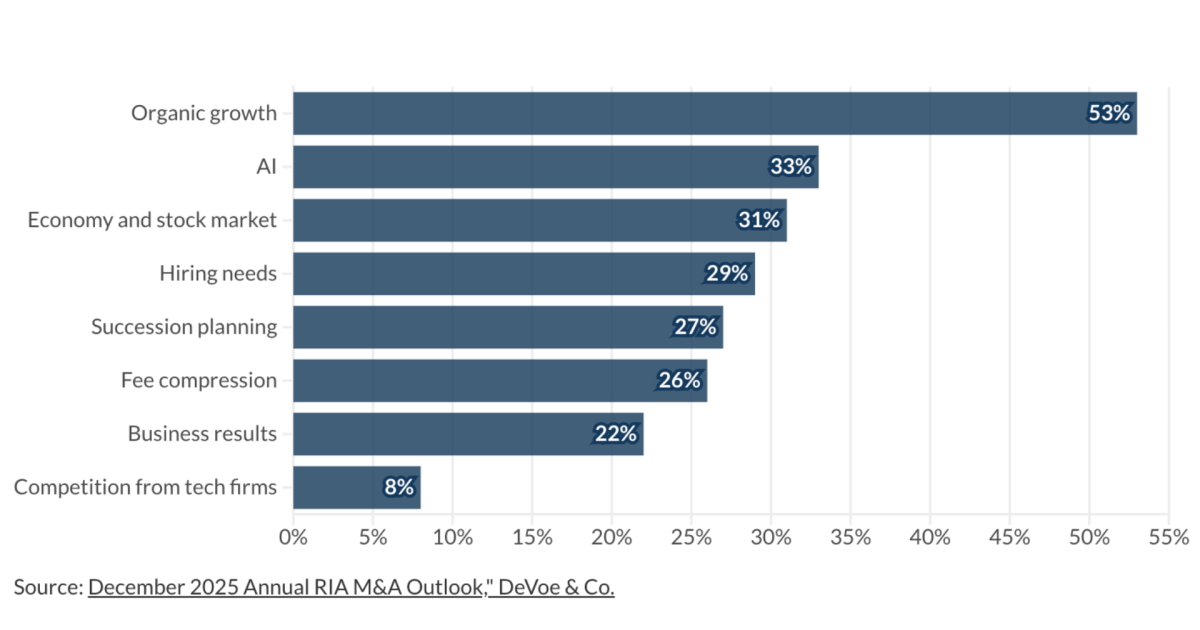Gold has been on a wild ride in 2025, surpassing even bullish expectations.
Late last year, Goldman Sachs Research analyst Lina Thomas projected gold could reach $3,000 per troy ounce by the start of 2026. That prediction turned out to be quite conservative, with the precious metal blowing past that milestone and surging to $3,500 per ounce by May.
And across the ensuing months, gold prices have continued to smash records, hitting a recent high of $4,300 per ounce.
Back in December 2024, Vince Stanzione, a trader and the CEO of educational publisher First Information, said he had long predicted gold would top $7,000 an ounce before 2030.
Today Stanzione said he remains bullish on gold but feels his original forecast “is now looking too low.”
READ MORE: Tech serving higher-value clients beats expanding capacity: Kitces
Advisors are taking note. Financial Planning’s October Financial Advisor Confidence Outlook (FACO) survey found that more than one-quarter (27%) of advisors anticipated increasing allocations to gold in the next three months, well above the typical range of 18% to 20%.
Turning to gold in times of uncertainty
Outside of the FACO survey, Lucas Wennersten, owner and founder of 49th Parallel Wealth Management in Scottsdale, Arizona, said he had increased gold allocations in June from 3% to 5%.
“I was looking to further diversify away from the U.S. stock market because of tariffs and increased uncertainty and had concerns about the strength of the U.S. dollar,” he said.
That sentiment reflects a broader market unease. Geopolitical tension and lingering fears about inflation are among the main drivers of gold’s popularity, factors advisors don’t see abating any time soon. But experts warn that what goes up must eventually come down.
READ MORE: How advisors can get noticed in a no-click search world
Gold has traditionally acted as a hedge in difficult times. That’s why the yellow metal has become more precious as more investors are willing to preserve their capital, said Julia Khandoshko, CEO at Mind Money, a European investment technology and financial engineering hub.
It’s also a haven during rising inflation, and when rates fall, it becomes even pricier, she said.
Ongoing instability will help gold be seen as a portfolio diversifier, said Jared Kessler, founder of global foreign exchange market advice platform Forex Broker.
“Gold may yet keep pressing the envelope in the near term, should inflation stay stubborn and real yields remain anemic,” he said.
Last month the Fed reduced rates by 25 basis points, and further cuts remain possible later this month.
“Historically, gold tends to perform strongly in low-rate environments, and there is no reason this story would not repeat now,” said Khandoshko.
‘Trees don’t grow to the sky’
Even as gold continues to set new records, experts cautioned its winning streak will not last indefinitely.
“Even considering that gold can save your funds from the turbulence, I believe that the decision to increase the share of gold in a portfolio should depend on the strategic vision of the client, and not on the current market conditions,” said Khandoshko.
While he has recently diversified into other alternatives, Wennersten said he did not plan to increase his gold allocations for the time being.
“Markets are cyclical, and asset prices tend to mean-revert,” he said. “The saying in the investment world is, ‘Trees don’t grow to the sky.'”
The long-term sustainability of gold’s rise will be largely dependent on monetary policy adjustments and investors’ risk appetite, said Kessler.
“Short-term pullbacks are normal, and as a hedge in today’s uncertain world, the overall trend still does favor gold,” he said.
Wennersten said his guess is gold will continue to hit new highs before eventually turning and heading down for some time.
“Like a broken clock is right twice a day, the impossible part is the timing,” he said. “It will go down at some point, but nobody knows what will happen with the price of any security in the short-term unless they have insider information.”


























